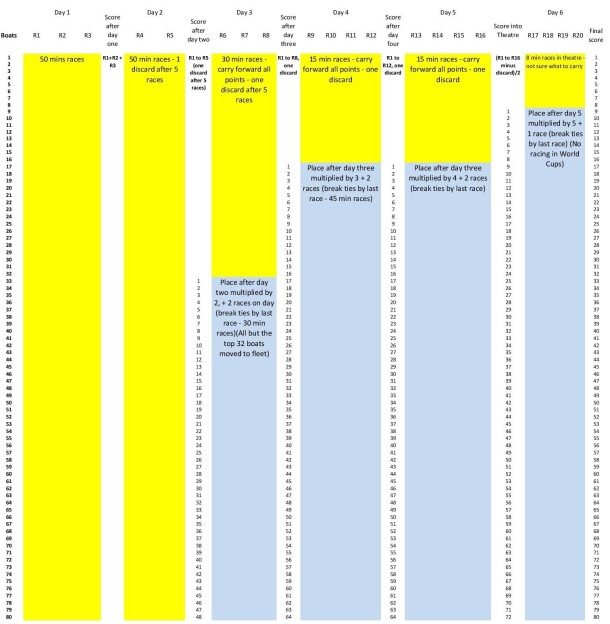The Format Committee of the 49er class continues to look into format options. We saw a tight battle in light conditions to close the 2013 North American Championships using ‘Points to 10’. We also saw an exciting finish to the 2013 Miami Olympic Classes regatta using the ‘Big Sixy’ format. Thanks to many contributions to our online forum discussion, many of the top sailors are also weighing in on how they see a Theatre Style finish fitting into a regatta, or if it has a place in the class at all.
Moving forward, we are proposing a format that should fit nicely into both large and small sized regattas, and would be suitable for world cups, the Olympics, our Europeans, and our Worlds. This format aims, as always, to produce a worthy champion of our regattas. In fact, this format is one where the winners should be able to stake a claim at being the best fleet racing sailors in the world, as we are aiming to test fleet racing in it’s various permutations.
Please note, we have submitted this format to ISAF and are still looking for feedback on whether we will be allow to try it for Palma, or any other world cup event. (UPDATE (13_03_11 ISAF did not allow us to test this format at Palma, so this option is on hold for now.)
The format for a 6 day regatta as follows, low point scoring throughout.
Days 1 and 2 – all boats sail in a single fleet for scheduled 5-6 races. Target time set by the fleet size, 40 boats and less, 30 mins – ~60 boat, 40 mins – ~ 80 boats, 50 mins. After 5 races there is a single drop race.
Day 3 – The top ½ (max 32) teams advance to the top fleet, the remaining move to the bottom fleet. 3 races, 30 mins target time. Race scores carry through with 1 drop.
Days 4 and 5 – the top 16 teams advance to the top fleet, the remaining teams move to the bottom fleet. 4 races per day, 15 mins target time. Race scores carry through with 1 drop.
Day 6 – Finals – the top 8 teams advance to the Theatre Style Final. 4 races with a target time of 8 mins, low point scoring, no drops. Teams carry through the ‘gaps’ in their scores divided in two. See below for more detail, but what that means is that if you have a 10 point lead, the team below you has 5 (10 divided by 2) more points than you with low points being the goal.
This format should produce a winner who has shown they can excel in the whole range of fleet racing formats available to sailing, from large fleets to small, and within a theatre. It also keeps all but one race through the whole series, rewarding teams who excel over the week. It make the final 3 days of racing suitable for a broadcast, in the sense that it is easy to broadcast theatre style racing, and should also be possible to do a good job of covering 16 boats racing for a 15 minute race.
Some challenges remain, primarily with regard to the first 2 days. Will race committees be able to start large fleets? Will the sailors enjoy the large fleet format? It offers a different challenge than typical within 49ers, though is quite common in other fleets. If it proves too difficult logistically, unfair in some way, or is not enjoyed by the sailors, it is easy to revert to our split fleet qualifying.
Scoring
Here is our take on scoring, and why we feel it’s necessary to ½ the gaps into the last day.
Lets pretend we would have sailed this format at the last olympics in the 49er.
The fleet was 20 Boats strong. Before the Medal race, the point gaps were as followed (non discard gap in brackets):
2nd placed boat has a Gap to 1st of 28(33)
3rd placed boat has a Gap to 2nd of 32(33)
4th placed boat has a Gap to 3rd of 1(4)
5th placed boat has a Gap to 4th of 5(6)
6th placed boat has a Gap to 5th of 1(2)
7th placed boat has aGap to 6t of: 1(-1)
8th placed boat has a Gap to 7th of 4(0)
First thing to notice is that discards make little difference in a small fleet like this one (note that we start with a big one and end with a small one, so discards might matter). The Maximum Difference between discard vers. no discard is 5 points (Nathans lead would have been even bigger without discards – so in this case he gets punished for his great sailing by the discard system).
Secondly: The two boats that sailed superior, enjoy a large gap, that gap is well deserved but it causes the last day to be a farce, broadcast wise. But you also notice that this is the exception – most gaps are quite small. So a rule of thumb could be:
Gaps are usually small and if they are not, they are well deserved.
So the question is: Shall we narrow down the gaps with some simple, smart but fair metric that ensures that the last day is not a farce. How much is narrowed down depends on a number of factors:
1. Most importantly: number of races on the last day:
5 races with 8 boats the min points a boat can generate are 5, the max points are 40 (so there are only 35 points one could ever gain)
4 races: 28 points to gain
3 races: 21 points to gain
So 3 races with 8 boats is a little better than a medal race (that has 18 points to gain).
As mentioned above, we need to consider that point gaps can get bigger than at the Olympics, because on the first days, there is many more boats on the course. At a 505 worlds with 185 boats, 9 races and 2 discards, the point differences after the final race (9 races) were:
2nd placed boat has a Gap to 1st of 4 (10 points with one discard)
3rd placed boat has a Gap to 2nd of 0(22points with one discard)
4th placed boat has a Gap to 3rd of 9(22points with one discard)
5th placed boat has a Gap to 4th of 12(0points with one discard)
6th placed boat has a Gap to 5th of 1(15points with one discard)
7th placed boat has aGap to 6t of: 1(15points with one discard)
8th placed boat has a Gap to 7th of 3(15points with one discard)
So without discards the gaps get bigger in large fleets. Not as bad as in the 505, because they had 185 boats and in the system proposed above the fleet shrinks quickly, but there is definitely an effect.
Based on these considerations we suggest the following:
1. One discard for all races (15) before the last day. No discards on the last day.
2. Narrow down gap of top 8 boats by 50% before the final day. But the minimum gap is one point.
3. Final Result = Gap + 4 final races
At the Olympics it would have looked like this before the final day.
2nd placed boat has a Gap to 1st of 14
3rd placed boat has a Gap to 2nd of 16
4th placed boat has a Gap to 3rd of 1
5th placed boat has a Gap to 4th of 3
6th placed boat has a Gap to 5th of 1
7th placed boat has aGap to 6t of 1
8th placed boat has a Gap to 7th of 2
The first two boats would still enjoy a big lead, but they could still be beaten. The gaps behind that are almost as small as if they would have carried the qualification result (like what they are using at EUROSAF now).
We think this could prove to become a very good tradeoff between fairness and excitement. We hope to try it in Palma. Fine tuning is possible in a few areas – bigger, smaller or no narrowing down of the fleet size or more or less final races.
Missing Days
We will write the contingency thoughts here as we develop them. Right now our only intention is that if a day is missed, then day 5 is eliminated from the schedule.







